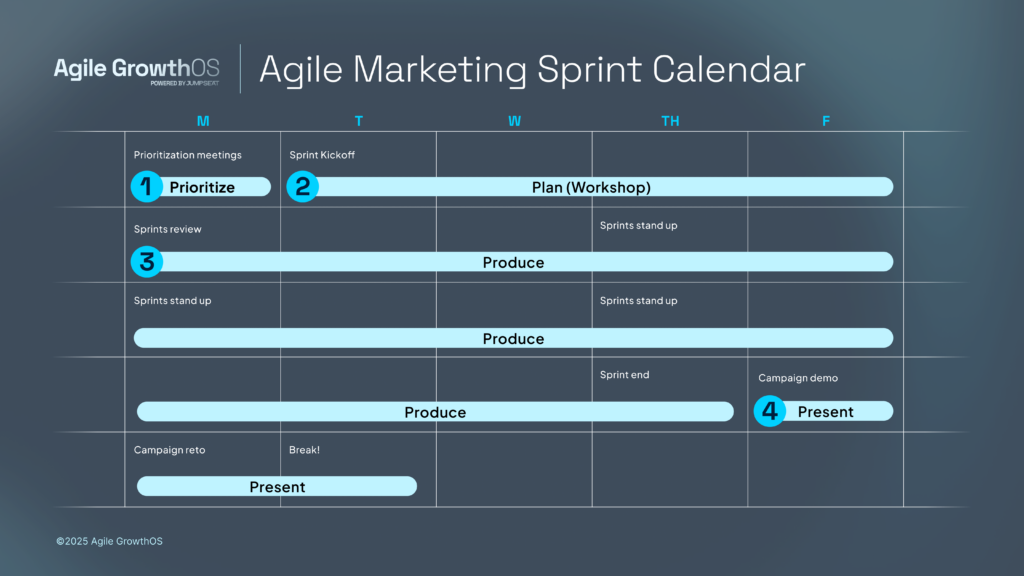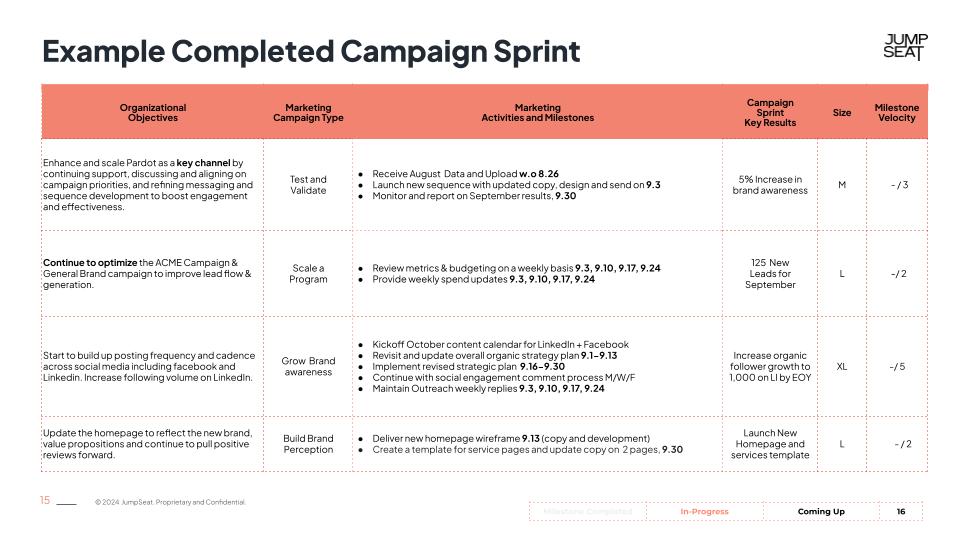Go ask 10 B2B marketers right now how they’re doing.
I’ll bet you $100 that at least five will respond with:
“Busy!!”
And that’s the problem.
- Busy doesn’t necessarily mean effective.
- Busy doesn’t necessarily mean strategic.
- Busy doesn’t necessarily mean winning.
There’s an inherent conflict in B2B go-to-market (GTM) execution right now.
Everyone wants to move fast.
Everyone wanted to iterate quickly.
But in reality? It’s tough not to wind up on the treadmill.
- Sales teams waiting on leads
- SDRs writing their own emails
- Marketing running isolated campaigns
- RevOps firefighting instead of driving strategic impact.
The result? It’s really tough to achieve true agility. True momentum. True alignment.
GTM teams don’t need more meetings, more strategy docs, or another vague “alignment” initiative.
They need Agile Sprints—structured, repeatable cycles that force speed, execution, and iteration.
The Problem with Waterfall in B2B in 2025
Waterfall project management wasn’t built for modern B2B go-to-market teams.
Yet many marketing, sales, and RevOps teams still operate like it’s 2010—with long planning cycles, rigid execution, and feedback loops so slow that by the time insights arrive, they’re already outdated.
Too Many Open Projects = Zero Focus
Everything is “high priority,” meaning nothing actually moves forward fast.
Unstructed Data= The “Black Box “Problem
Insights are buried in spreadsheets, scattered across CRMs, or lost in Slack. Instead of real-time intelligence, teams are making big bets based on lagging indicators.
Random Acts of Sales & Marketing
Without a tight, iterative execution model, teams default to scattershot campaigns, one-off outbound plays, and inconsistent messaging.
Lack of Proper Feedback Loops
In Waterfall, feedback often comes only after a campaign is finished. By then, the market has shifted, competitors have adapted, and the strategy is already stale.
Now that we know the wrong way, let’s do it the right way.
The Agile GTM Framework We Designed
Traditional Agile was built for product and engineering teams. But in GTM? You need speed, clarity, and revenue impact.
We took Agile principles and built a version that actually works for GTM execution.
Strategic Must-Haves for Agile GTM:
- Start with your organizational objective→ If it doesn’t tie back to revenue, it doesn’t matter.
- Associate a marketing strategy with each effort→Execution without strategy is wasted effort.
- Always associate a KPI to an effort→ If you can’t measure it, you can’t improve it.
How to Keep GTM Agile:
- 30% Strategy / 70% Execution →Stop over-planning, start shipping.
- No Random Acts of Sales & Marketing → Every action should compound.
- Prioritize External Feedback Over Internal Feedback → What your audience thinks > What your team thinks.
Agile GTM Execution Rules:
- Run Experiments to Confidently Know What Works → Don’t assume—test.
- Timebox Everything → Limit work in progress to avoid bottlenecks.
- Ensure the Pace Is Sustainable→ Growth is about sprints, but not sprinting. It’s about sustained momentum.
- Quantify Efforts Wherever Possible→ What gets measured, gets improved.
- Reflect & Adjust → Retrospectives are your best tool for rapid improvement.
- Celebrate Wins→ Momentum is built on progress—acknowledge it.
Agile GTM isn’t about being busy—it’s about moving with precision.
Why Agile Sprints Are Actually Fun (Yes, Really)
Most GTM teams don’t associate “fun” with execution. But here’s the thing—agility doesn’t just make you more effective, it makes the work more enjoyable.
Here’s why:
- More momentum, less waiting. Instead of planning for months and hoping for results, you’re launching, iterating, and stacking small wins every few weeks. Progress feels tangible—and that’s energizing.
- You communicate more often—but in a way that actually helps. No more endless, low-value meetings. Agile Sprints create quick, focused touchpoints that drive alignment and keep teams in sync—without wasting time.
- You say “no” with confidence. When priorities are clear, you stop chasing distractions. No more scrambling to “just get something out.” You focus on what actually moves the needle, and that clarity? It’s a game-changer.
- You celebrate wins in real-time. Instead of waiting for the end of a quarter (or worse, the end of the year) to recognize progress, you’re constantly hitting milestones and feeling the momentum build.
- No more running around like a chicken with its head cut off. You have a system. You know what to work on, when to ship it, and how to improve. The chaos disappears, and work becomes a whole lot more fun and fulfilling.
When GTM teams adopt Agile Sprints, they don’t just get faster—they get happier.
Now, let’s break down exactly how to make it happen.
Talking about Agile Sprints is easy. Experiencing one? That’s when everything clicks.
The energy shifts. The team rallies. Work stops dragging and starts compounding.
At AGOS, we’ve run 700+ GTM sprints and seen it firsthand—when teams commit to this process, things move.
Not in six months. Not next quarter. Now.
The Four Phases of an Agile Sprint
- Prioritize → Identify the highest-impact work that aligns with business objectives.
- Plan → Break it down into actionable steps with clear ownership.
- Produce → Execute with speed, iterate in real-time, and ship fast.
- Present → Measure impact, capture learnings, and refine for the next sprint.
Why We Love a Monthly Sprint Cadence
We’ve tested different sprint lengths, and one month hits the sweet spot.
- A perfect balance of strategy (25%) and execution (75%) → You have just enough time to plan and adjust, but the focus is on getting things done.
- Any longer than a month? You risk drifting into lower execution, more meetings, and less momentum.
- Any shorter? You end up with 50% planning, 50% execution—which means you’re spending too much time thinking and not enough time shipping.
A monthly sprint keeps teams focused, agile, and accountable.
Here’s what an Agile Sprint Monthly Cadence looks like in action:

Now, let’s break it down step by step—so you can implement sprints that actually move revenue.
Step 1: Prioritize—Pick What Actually Matters
The greatest killer of momentum on revenue teams? Random acts of sales and marketing.
It happens all the time:
- “Let’s run a webinar on the new solution to get the word out.”
- “We need a new ebook or white paper.”
- “What if we ramp our LinkedIn ads?”
- “A board member said we need to master outbound!”
These all start with tactics, not strategies. Even the last one.
Doing a lot of things feels productive. It makes teams look busy. But it doesn’t mean you’re moving the business forward in a meaningful way.
That’s why Agile Sprints never start with tactics. They start with business objectives.
Here are some quick examples that are fantastic input for a GTM team:
- We want to launch a new capability to capture the growing market and cross-sell or upsell to our current client base.
- We have new clients in a particular vertical and want to expand our presence there.
- The value we provide to our clients increases every quarter, and we need to figure out how to increase LTV.
- There’s a new market forming around innovative technology. We’re unsure if it’s viable yet but should explore it to learn more.
We’re not well known within a particular segment, vertical, or region. We should build awareness to facilitate future sales.
Here are six solid, Mad-Lib style organizational objectives:
[Action- Packed Strategy Execution Mad Libs]
- Enhance and scale [key channel] by [specific execution steps], ensuring [desired outcome].
- Launch [content type] on [platform] to [target audience], with the goal of [key objective].
- Optimize [campaign name] to improve [specific metric] by [tactical improvements].
- Develop and publish [content frequency] of [content type] to [strategic goal, e.g., support sales, improve SEO, nurture leads].
- Increase [channel presence] by [specific activities, e.g., increasing posting cadence, growing following] to drive [key metric].
- Update [website area] to reflect [new messaging/brand strategy] and ensure [specific outcome].

How many organizational objectives should you choose?
This process is infinitely scalable.
We’ve run anywhere from a single monthly sprint all the way up to 30+ on a large, multinational team and 250+ demand team members. Here’s a rough approximation.
Here’s a structured chart breaking down the number of Agile Sprints to run based on team size and complexity:
|
# of Sprints |
Best For |
Description |
|
1 Sprint |
MVP & Proof of Concept |
A single sprint to validate the process, test a new initiative, or align a small team on a focused objective. |
|
3 Sprints |
Small Revenue Teams |
Ideal for early-stage startups or lean teams looking to create structure and momentum without overcomplicating execution. |
|
4-6 Sprints |
Fast-Scaling Revenue Teams |
A great balance for companies ramping up demand generation, optimizing sales processes, and aligning GTM functions. |
|
7-10 Sprints |
Mid-Sized GTM Teams |
Works well for companies with multiple sales segments, marketing functions, or RevOps integration needs. |
|
10-20 Sprints |
Large Organizations |
Designed for organizations with multiple business units, stakeholder groups, and regional go-to-market teams. |
|
20+ Sprints |
Enterprise Revenue Teams |
Built for complex, multinational organizations managing multiple markets, product lines, and extensive cross-functional collaboration. |
This structure ensures teams scale Agile Sprints based on their needs—without overwhelming execution or losing focus.
Step 2: Plan—From organizational Objectives to Detailed Execution
Once you’ve set your key objectives, it’s time to break them down into detailed project plans—assigning ownership, deadlines, and deliverables for each phase of execution.
This two-step approach ensures strategy doesn’t stay abstract and that every sprint has a clear, structured path to execution.
Step 1: Establish Milestones
Before jumping into individual tasks, set the key milestones that define success for the sprint. These are your non-negotiable deliverables—the big rocks that must be completed by the end of the sprint.
Example: Creative Concept Development Sprint
- Creative Concept Kick-Off → Align on initial vision, themes, and direction (Day 2)
- Creative Concept Presentation → Present v1 of design framework (Day 14)
- Creative Concept Round II → Apply feedback, refine visuals (Day 20)
- Final Creative Direction Approved → Leadership sign-off on creative (Day 28)
Why This Works:
- Keeps execution focused—teams know what they’re working toward.
- Creates clear check-in points to course-correct early.
- Ensures the right stakeholders are involved at the right time.
Step 2: Build the Detailed Project Plan
With the milestones locked, break them down into specific tasks, owners, and deadlines.
| Milestone | Task | Owner | Deadline |
| Creative Concept Kick-Off | Gather competitive inspiration & reference materials | Marketing Lead | Day 1 |
| Define creative direction & messaging themes | Creative Director | Day 2 | |
| Creative Concept Presentation | Draft initial design mockups | Design Team | Day 10 |
| Review & refine for internal presentation | Marketing Lead | Day 12 | |
| Present v1 creative to leadership | Creative Director | Day 14 | |
| Creative Concept Round II | Apply feedback & finalize design concept | Design Team | Day 18 |
| Align marketing & sales collateral to creative | Marketing Team | Day 20 | |
| Final Creative Direction Approved | Final stakeholder review | CMO / Leadership | Day 26 |
| Sign-off & finalize assets | Creative Director | Day 28 |
Why This Works in Agile Sprints
- Keeps projects moving fast. No waiting until the last minute—work is broken into manageable pieces.
- Creates clear ownership. Every task has a single DRI (Directly Responsible Individual).
- Identifies bottlenecks early on. Teams can quickly adjust if something isn’t working.
With milestones in place and a detailed plan to execute, it’s time for the real magic—execution.
Step 3: Produce—Three Weeks to Execute, Test, and Learn
Execution isn’t about working harder—it’s about working smarter, faster, and iteratively. About three-quarters of the sprint should be spent in full execution mode—launching, testing, learning, and optimizing in real time.
How Long Should a Campaign Take to Develop?
Should a campaign take three days, weeks or three months? Without sprints, often there’s not a great answer inside teams. Now there.
Why? Because timeboxing is magic.
When teams set tight execution windows, work doesn’t just get done—it gets done faster and smarter.
The Rule: Break Large Campaigns into Multiple Sprints
If a campaign is too big to finish in a sprint, don’t extend the timeline—break it down into structured phases.
Example: Large Campaign Split into Sprints
- Sprint 1 → Brand Messaging Locked In
- Sprint 2 → Creative Concept Developed
- Sprint 3 → Full Campaign Built & Launched
Not overwhelming. Neat. Orderly. Structured.
Each sprint moves the project forward with clear deliverables, expectations, and alignment—so there’s no “waiting” and no “we’ll get to it next quarter.”
The Magic of Constraints: Why Every Sprint Has a Timebound Commitment
One of the biggest mistakes GTM teams make? Running campaigns either too short or indefinitely long.
Without clear time constraints, projects either:
- Drag on forever, losing momentum and clarity.
- Get cut short before they’ve had a chance to generate real impact.
Agile Sprints solve this by forcing timebound execution with a clear KPI for each sprint.
At the end of every sprint, you ask a simple but powerful question:
Did we achieve what we set out to achieve?
Here’s the magic—it doesn’t actually matter what the answer is.
- Yes? Great—move on to the next priority.
- No, but we’re close? Keep going—another sprint will get us there.
No, and this isn’t working? Stop, pivot, and reallocate resources elsewhere.
By simply forcing this moment of reflection, teams apply critical thinking to every initiative.
Over time, this eliminates wasted effort and ensures only the highest-value activities get resources.
Key Takeaway: The most successful GTM teams aren’t just executing—they’re constantly evaluating and optimizing.
Step 4: Present—Celebrate, Share, and Improve
A sprint isn’t just about execution—it’s about bringing the work to life, sharing wins, and learning together.
Too often, great work happens, but only a handful of people see it. Momentum comes from visibility. When teams take the time to present, reflect, and celebrate, they don’t just improve results—they build energy, alignment, and pride in their work.
Share the Work, Celebrate the Wins
At the end of each sprint, take a moment to:
✅ Showcase what was built → Give the team and company visibility into the work. Whether it’s a campaign launch, new messaging, or a revamped sales process, make it known.
✅ Highlight the impact → Tie results back to the sprint’s KPI. Did it drive more leads? Improve engagement? Spark better conversations? Share the data, but also the stories behind it.
✅ Recognize contributions → Every sprint is a team effort. Call out big wins, creative problem-solving, and key contributors. Momentum builds when people feel seen and valued.
The Magic of Retros: Learning & Improving Every Sprint
A Sprint Retrospective (Retro) is where great teams get even better. It’s not about fixing problems—it’s about optimizing what’s working and making small tweaks to improve every cycle.
Three simple but powerful questions:
- What worked well? → What should we do more of?
- What could be better? → Where can we refine and optimize?
- What should we change for next time? → What small shift will improve the next sprint?
This isn’t about overanalyzing—it’s about capturing insights, making small improvements, and keeping the momentum going.
Campaign Sprint Process Ceremonies
Agile Sprints aren’t just about structure—they’re about rhythm. The right set of ceremonies ensures alignment, visibility, and continuous improvement across every sprint. Here’s how to keep the process running smoothly:
1. Prioritization Session
Before each sprint kicks off, marketing leadership meets to plan and align on the highest-impact priorities for the next sprint. This is where strategy and execution connect.
2. Sprint Kickoff
At the start of the sprint, leadership walks the team through:
- Campaign priorities → What are we working on?
- Roles & responsibilities → Who owns what?
- Expected outcomes → What does success look like?
3. Campaign Sprint Plan Review & Approval
After roughly a week of ideating and estimating, the team reconvenes to finalize the plan and ensure everything is set before execution begins.
4. Daily Stand-Ups
During the production phase, quick 15-minute check-ins (daily or a few times per week) help teams:
- Flag roadblocks
- Adjust execution
- Stay aligned and moving
5. Campaign Sprint Demonstration
At the end of the sprint, the team presents the work—sharing what was built, the impact, and key insights. This is a moment to celebrate wins, learn from challenges, and recognize contributions.
6. Sprint Retrospective
Along with the demonstration, teams dedicate at least an hour to review what worked, what could be improved, and what to adjust for next time. This is how execution gets faster and smarter every sprint.
7. Campaign Sprint Break or Innovation Days
Before the next sprint begins, bake in time to:
- Celebrate the team’s work
- Provide downtime to recharge
- Host innovation days where teams can experiment with new ideas
You’ll be amazed at how much this fuels morale, culture, and retention.
Final Thought: Build a Culture That Fuels Growth
Agile Sprints aren’t just about speed—they create a rhythm of progress, visibility, and continuous improvement.
When teams take the time to share, celebrate, and learn together, execution becomes more than just work—it becomes a force that drives the entire company forward.






